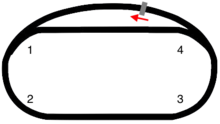1978 Capital City 400
| Race details | |||
|---|---|---|---|
| Race 23 of 30 in the 1978 NASCAR Winston Cup Series season | |||

Layout of Richmond International Speedway
|
|||
| Date | September 10, 1978 | ||
| Official name | Capital City 400 | ||
| Location | Richmond Fairgrounds Raceway, Richmond, Virginia | ||
| Course | Permanent racing facility 0.542 mi (0.872 km) |
||
| Distance | 400 laps, 216.8 mi (348.9 km) | ||
| Weather | Hot with temperatures approaching 95 °F (35 °C); wind speeds up to 17.26 miles per hour (27.78 km/h) | ||
| Average speed | 79.568 miles per hour (128.052 km/h) | ||
| Attendance | 18,000 | ||
| Pole position | |||
| Driver | DiGard Motorsports | ||
| Most laps led | |||
| Driver | Neil Bonnett | Osterlund Motorsports | |
| Laps | 276 | ||
| Winner | |||
| No. 5 | Darrell Waltrip | DiGard Motorsports | |
| Television in the United States | |||
| Network | untelevised | ||
| Announcers | none | ||
The 1978 Capital City 400 was a NASCAR Winston Cup Series race that took place on September 10, 1978, at Richmond Fairgrounds in Richmond, Virginia.
By 1980, NASCAR had completely stopped tracking the year model of all the vehicles and most teams did not take stock cars to the track under their own power anymore.
In 1953, Richmond International Raceway began hosting the Grand National Series with Lee Petty winning that first race in Richmond. The original track was paved in 1968. In 1988, the track was re-designed into its present D-shaped configuration
The name for the raceway complex was "Strawberry Hill" until the Virginia State Fairgrounds site was bought out in 1999 and renamed the "Richmond International Raceway". The Strawberry Hill Races, which are a series of steeplechase horse races were formerly held the third Saturday of April at the Richmond Raceway Complex. In 2001, the races were moved to Colonial Downs in New Kent County, Virginia's first Thoroughbred racetrack.
Four hundred laps were completed on an oval track spanning 0.546 miles (0.879 km) per lap for a grand total of 216.8 miles (348.9 km) of racing. The race was completed within two hours and forty-three minutes of the first official green flag of the race.Darrell Waltrip would end up defeating Bobby Allison (who drove a 1978 Ford Thunderbird) by only one second. Neil Bonnett started chasing down Waltrip on pit road and slammed into Waltrip's vehicle; forcing Bill France, Jr. to put them on probation for the remainder of the year. The spectators were incredibly disgruntled after Darrell Waltrip's victory so Waltrip needed police protection in order to make it to the post-race interviews.
When I passed Neil, I was on the inside and he was on the outside. It think it's pretty poor strategy when he doesn't move up. He actually cut into me.
Eighteen thousand people were a live witness to five yellow flags being used for twenty-seven laps in addition to 16 lead changes by the drivers. The pole position speed was acquired by Darrell Waltrip's Chevrolet Monte Carlo with a qualifying speed of 91.964 miles per hour (148.002 km/h) during his solo run. Meanwhile, the average speed of the actual race would be 79.568 miles per hour (128.052 km/h).
...
Wikipedia
